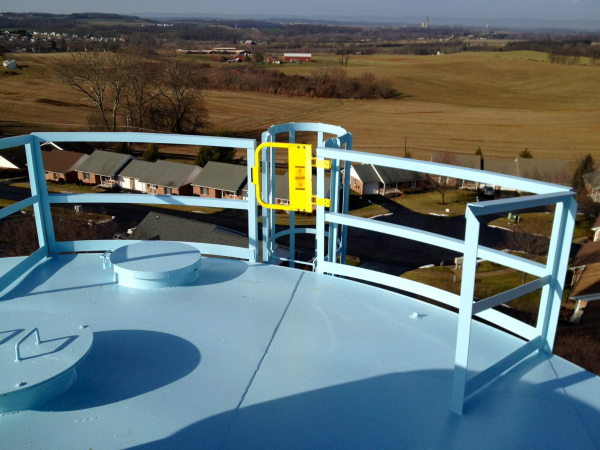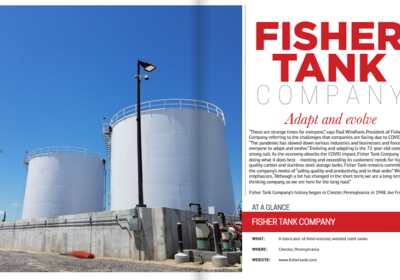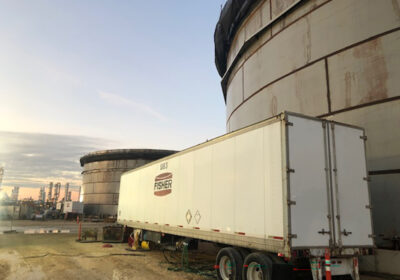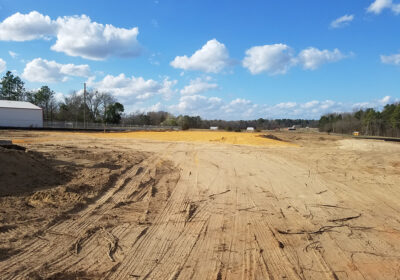TOP 5 STORAGE TANK REPAIR MYTHS

We welcome Christine Gunsaullus, Director of Technical Services for Mumford-Bjorkman Associates, to the Think Tank Blog this week! Christine’s 19 years of tank and coatings experience help with spec writing, reviewing reports, and project management services to get tanks built and rehabbed. She routinely speaks at industry and AWWA conferences, and is an active member of AWWA, PMAA, and SWE.
Top Storage Tank Repair Myths
Tank owners and engineers occasionally hire a competitor to evaluate a tank, then come to Mumford-Bjorkman Associates (MBA) with the inspection report and ask, “Do I really need to do this?” Maybe not, and here’s why…
Pressure Grouting Under the Bottom
There are rare occasions when a tank bottom or inlet/outlet pipe leaks, the soil and materials under the bottom get washed away, and pressure grouting is needed to stabilize the bottom. This is needed on approximately one in every 150 tank evaluations we perform each year. However, we’ve reviewed dozens of inspection reports where there’s absolutely NO indication of a leak or voids beneath the bottom, or settlement of the center column, yet the report STILL calls for pressure grouting. Even if you stand inside an empty tank and feel sections of the bottom flex up and down a bit, don’t worry — that’s completely normal. The bottom is supposed to do that; it will settle down into place during filling. So save your money.
Perimeter Roof Handrails
OSHA addresses this issue in an OSHA Standard Interpretation, which explains that a tank roof is not a platform, so perimeter handrails are not needed. The roof, however, is a “walking/ working surface”, and as such, requires fall protection. This is addressed in the various AWWA tank standards, like D100-11 Sections 5.4.2.5 (Elevated Steel Tanks) and 7.4.2.3 (Ground Steel Standpipes & Reservoirs), which call for platforms, steps, handrails, or non-skid areas based on the slope of the roof.
And don’t forget your own safety gear, like your harness and lanyard, when climbing!
Overcoating
When feasible, overcoating saves money and time. And generally, a tank exterior can be overcoated once or twice during its lifespan. However, there are a few inspection firms/ contractors who don’t want to go to the trouble of fully blasting a tank down to bare steel then painting it. Their report inevitably “recommends” overcoating, even when the coating is old (25+ years), too thick (20+ mils), or too brittle (edges peel back with a putty knife).
Don’t fall for the “very tightly adhered” spiel with your coatings, unless you know the adhesion was properly tested in numerous areas, and other factors like age and thickness were considered. Otherwise, your tank may start peeling a few years after overcoating, and you’ll be right back where you started, but with no money for repairs.
OSHA Upgrades Are Grandfathered In, Right?
Nice try, but no cigar. Tanks that are more than 40 years old almost always have undersized ladders (OSHA 1910.27 Fixed Ladders) and handrails (OSHA 1910.23 Floor & Wall Opening & Holes), and newer tanks may have old, damaged, or painted-over safety climbs. We always recommend making OSHA upgrades during a tank rehab, because there are no “grandfather” clauses in OSHA 1910.23 or 1910.27. OSHA has issued citations for ladders that are not compliant, as described in this OSHA Standard Interpretation.
Besides reducing your risk of litigation if there’s an accident, it’s just the right thing to do to protect your workers and others on your tanks.
AWWA Upgrades Are Required Immediately
We recently performed a Remotely Operated Vehicle (ROV) underwater evaluation in a 70′ high standpipe, and found something very unusual. Three sections of the interior ladder had fallen to the bottom of the tank (see top photo), and it was only eight years old! It was originally designed and constructed without an interior ladder, due to freezing concerns based on its location. However, a new interior ladder was installed a few years ago by an underwater diving welder as part of a series of AWWA upgrades the owner thought they had to do. The splices between ladder sections were not in accordance with OSHA and weren’t fully welded, the shell surface wasn’t prepped prior to welding, and worst of all, the shell stand-offs were not seal welded. At best, we found indications of welding on only two out of four sides of the stand-offs (see bottom photo). It’s a wonder somebody wasn’t killed using this ladder.
So when are AWWA upgrades required?
The AWWA Standards are guidelines for best practices. They aren’t laws or codes, but they are based on the wisdom and experiences of the best water professionals in the industry. The standards are updated every few years, and the changes and additions are things that will extend the life of your tank, or make it easier to maintain… but they typically aren’t required immediately.
MBA usually recommends AWWA upgrades when your tank is repainted. These upgrades (i.e. roof vent, manways) are typically 5% of the overall budget, so it’s a small price for a far superior product.
IMPORTANT NOTE: There are a few repairs that should never be delayed. These include securing and clearing the screening on roof vents and overflows, and sealing any holes in the roof or tank that could allow dirt and debris, or worse, birds and animals, to enter, which is just yucky! If you ever have questions about an old tank inspection report that MBA or anyone else prepared, we’re happy to review it with you and offer guidance.
Special thanks to Christine Gunsaullus and Mumford-Bjorkman Associates, a coating inspection and consulting company that specializes in Water Storage Tanks, Underwater Inspections, and Protective Coatings Inspection.
Click here to read more of our blogs





